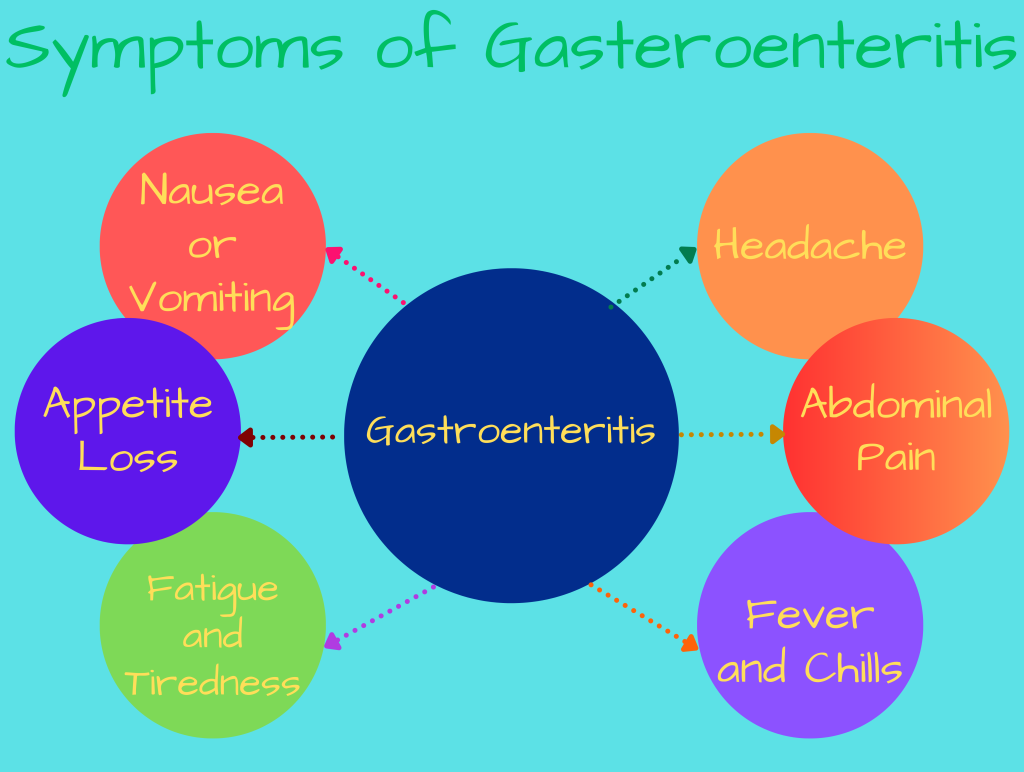Viral gastroenteritis is an intestinal infection characterized by symptoms such as watery diarrhea, stomach cramps, nausea, vomiting, and sometimes fever.
The main types are norovirus and rotavirus. Typically, you get exposed to a virus through various means:
Norovirus:
Norovirus stands out as the most frequent cause of viral gastroenteritis. Symptoms usually appear 12 to 48 hours after exposure, lasting for 1 to 3 days. It’s very contagious, spreading easily and quickly.
Rotavirus affects both adults and children, with children being more susceptible to severe symptoms like dehydration. It tends to peak in the U.S. from January through June. Symptoms typically start 1 to 3 days post-exposure, lasting 5 to 7 days.
Astrovirus symptoms typically emerge 4 to 5 days post-exposure and last for 1 to 4 days. It usually causes mild infections, primarily affecting children under 5 and adults over 65, as well as those with weakened immune systems.
Adenovirus comes in several strains and commonly causes respiratory symptoms but can also lead to stomach issues. Symptoms usually appear 3 to 10 days after exposure, lasting up to 2 weeks. Adults may contract it in crowded environments like dormitories or nursing homes.
Norovirus infects people of all ages, while rotavirus, adenovirus, and astrovirus primarily affect infants and young children, though they can also infect adults. Viruses can trigger viral gastroenteritis throughout the year, but norovirus, rotavirus, and astrovirus are more prevalent during the winter months.
Bacteria, such as Escherichia coli and salmonella, can also cause gastroenteritis, though less frequently than viruses. Salmonella and campylobacter are the most common bacterial culprits in the U.S., often spread through undercooked poultry or contaminated water.
Shigella is commonly passed around in daycare centers and through contaminated food and water. Parasites like giardia and cryptosporidium can cause gastroenteritis, typically contracted from contaminated swimming pools or water.
Other unusual causes of gastroenteritis include exposure to heavy metals in drinking water, consumption of acidic foods, toxins found in certain seafood, and certain medications such as antibiotics or chemotherapy drugs.

Protection and Prevention
Adopt Simple Hygiene Measures
To shield yourself from gastroenteritis and prevent transmission, it’s essential to adopt simple hygiene measures:
Firstly, wash your hands often, ensuring to do so:
Before, during, and after preparing meals.
Prior to eating
Before breastfeeding or feeding a child
Following changing a child’s diaper
Additionally, disinfect toilet seats and surfaces or objects that may have been contaminated by stool or vomit, such as toys or items that a child puts in their mouth.
Consider putting toddlers in superabsorbent diapers to prevent leakage and maintain cleanliness.
Furthermore, ensure to prepare and clean feeding bottles under the cleanest possible conditions.
For further guidance on hygiene measures, refer to the page “Steps for Limiting the Spread of Respiratory Infectious Diseases.”
Vaccinate Your Children
The most effective way to safeguard them against gastroenteritis is by administering vaccination against Rotavirus. Children should receive the first dose of the vaccine before reaching 20 weeks of age and the final dose before 8 months.
Treatment Methods
When addressing gastroenteritis, the primary aim is to rest the stomach and intestines. This involves refraining from consuming solid food for a period and solely drinking clear liquids. As your symptoms alleviate, transitioning to soft bland foods that are easily digestible is advisable.
If you’ve experienced frequent vomiting, it’s best to opt for small, frequent sips of liquids. Drinking too much at once, even a small amount, may trigger further vomiting.
Your choice of liquids is crucial. If water is the only liquid you can tolerate without vomiting, that is acceptable. However, if vomiting has been persistent or prolonged, it’s essential to replenish lost minerals, such as sodium and potassium. Consult your healthcare provider regarding sports drinks or other rehydration beverages that could aid in replacing these minerals.
Other suitable clear liquids include weak tea and apple juice. Additionally, you may consume caffeine-free soft drinks (such as 7-UP) after allowing them to lose their carbonation. Cold liquids may be easier to tolerate. It’s advisable to avoid acidic liquids (like orange juice), caffeinated beverages (such as coffee), or highly carbonated drinks. Refrain from consuming milk until diarrhea has ceased.
You may introduce soft bland foods once you’ve abstained from vomiting for several hours and can ingest clear liquids without further upset. Opt for soda crackers, toast, plain noodles, gelatin, eggs, applesauce, and bananas as initial choices. Avoid acidic, spicy, fatty, or fibrous foods (such as meats, coarse grains, and vegetables), as well as dairy products. You can gradually reintroduce these foods after approximately 3 days once all symptoms of illness have subsided.
Sometimes, treatment may involve prescription medication to alleviate nausea, vomiting, or diarrhea.
Nonprescription medication is available for diarrhea treatment and can be highly effective. When using it, ensure to follow the dosage instructions provided on the package. If you have underlying health conditions, always consult your healthcare provider before using any medication for diarrhea.
